Auckland Island, the main island in the group at 510-km², along with Adams, Disappointment, Enderby and several other smaller islands, forms part of New Zealand’s Auckland Islands National Nature Reserve.
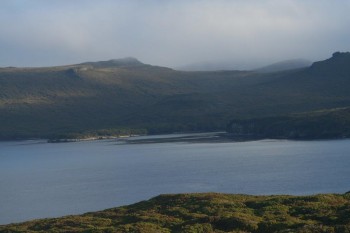
A view of Auckland Island, photograph by Pete McClelland
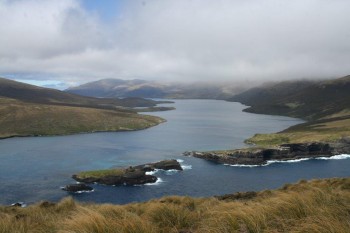
Carnley Harbour, in the south of Auckland Island, photograph by Pete McClelland
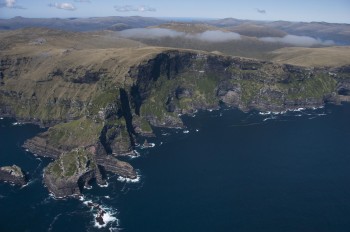
Cliffs, west coast, Auckland Island, photograph by Barry Baker
The island’s coastal vegetation includes Southern Rata Metrosideros umbellata and introduced Subantarctic Tree Daisy Olearia lyallii forest. The inland habitats contain Hebe elliptica shrubland, Poa litorosa tussock grassland and fellfield along with flowering megaherbs such as the Campbell Island Daisy Pleurophyllum speciosum, Ross Lily Bulbinella rossii and Macquarie Island Cabbage Stilbocarpa polaris.
ACAP-listed species that have been reported breeding on the main Auckland Island are the Southern Royal Albatross Diomedea epomophora, (a few in the north in 1972/73) the Gibson’s subspecies of Antipodean Albatross D. antipodensis gibsoni, White-capped Albatross Thalassarche steadi (4741 (4603 - 4879) pairs estimated by aerial photography at South West Cape in 2014), Light-mantled Sooty Albatross Phoebetria palpebrata (in numbers on coastal cliffs around the island) and Northern Giant Petrel Macronectes giganteus (a small colony near South West Cape reported in 1972/73) No definite record of breeding by White-chinned Petrel Procellaria aequinoctialis has as yet been found although the species does breed on some other islands in the group.
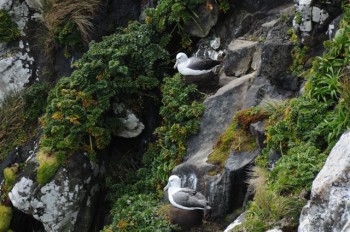
White-capped Albatrosses, South West Cape, Auckland Island, photograph by Pete McClelland
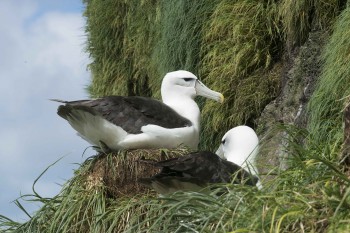
A White-capped Albatross pair, South West Cape, Auckland Island, photograph by Barry Baker
Alien mammals that currently occur on the island are feral Domestic Pigs Sus scrofa domesticus, feral cats Felis catus and House Mice Mus musculus, the last apparently in surprisingly low densities, based on a recent trapping exercise (click here). Feral Domestic Goats Capra aegagrus hircus previously occurred but were eradicated by 1992. The pigs are known to prey upon the contents of albatross nests; recently c. 70 were shot from a helicopter as a feasibility exercise.
The island group is surrounded by the Auckland Islands/Motu Maha Marine Reserve that covers an area of c. 484 000 ha (click here).
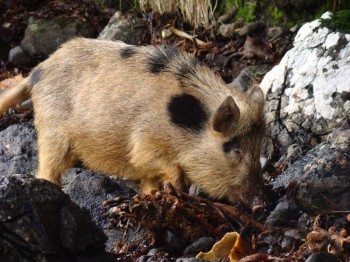
An Auckland Island pig, photograph by Pete McClelland
Auckland Island falls within the New Zealand Sub-Antarctic Islands World Heritage Site inscribed in 1998 which includes five island groups (Antipodes Islands, Auckland Islands, Bounty Islands, Campbell Island and the Snares Islands). The island is also part of the proposed Auckland Islands Important Bird Area (IBA).
With thanks to Barry Baker, Pete McClelland, Kalinka Rexer-Huber and James Russell for information and photographs.
Selected Literature:
Baker, G.B., Jensz, K. & Cunningham, R. 2013. White-capped Albatross Population Estimate — 2011/12 and 2012/13 Final Report. Wellington: Department of Conservation. 22 pp.
Baker, G.B., Jensz, K., Cunningham, R., Holdsworth, M. & Chilvers, B.L. 2015. White-capped albatross aerial survey 2015 Draft Final Report. Report prepared for Department of Conservation Contract 4625. [Kettering]: Latitude 42 Environmental Consultants. 20 pp.
Bell, B.D. 1975. Report on the birds of the Auckland Islands Expedition 1972-73. In: Yaldwyn, J.C. (Ed.). Preliminary Results of the Auckland Islands Expedition 1972-73. Wellington, Department of Lands and Survey. pp. 136-142.
Dawson, E.W. 2012. The Auckland Islands/Motu Maha/Maungahuka/subantarctic New Zealand: a working bibliography. The Hutton Foundation New Zealand Special Papers No. 7. Eastbourne; Hutton Press. 507 pp.
Department of Conservation 1998. Conservation Management Strategy Subantarctic Islands 1998-2008. Southland Conservancy Conservation Management Planning Series No. 10. Wellington: Department of Conservation. 113 pp.
Department of Conservation 2006. Marine Protection for the New Zealand Subantarctic Islands: a Background Resource Document & CD ROM. Wellington: Department of Conservation. 48 pp.
Eden, A.W. 1955. Islands of Despair. Being an Account of a Survey Expedition to the sub-Antarctic Islands of New Zealand. London: Andrew Melrose. 212 pp.
Fraser, C. 1986. Beyond the Roaring Forties New Zealand’s Subantarctic Islands. Wellington: Government Printing Office Publishing. 214 pp.
Peat, N. 2003. Subantarctic New Zealand: a Rare Heritage. Invercargill: Department of Conservation Te Papa Atawhai. 96 pp.
Robertson, C.J.R. 1975. Report on the distribution, status and breeding biology of the Royal Albatross, Wandering Albatross and White-capped Mollymawk on the Auckland Islands. In: Yaldwyn, J.C. (Ed.). Preliminary Results of the Auckland Islands Expedition 1972-73. Wellington, Department of Lands and Survey. pp. 143-151.
Russ, R. & Terauds, A. 2009. Galapagos of the Antarctic: Wild Islands South of New Zealand. Christchurch: Heritage Expeditions. 224 pp.
Taylor, G.A. 2000. Action Plan for Seabird Conservation in New Zealand. Part A, Threatened Seabirds. Threatened Species Occasional Publication No. 16. Wellington: Department of Conservation. 234 pp.
Thompson, D., Sagar, P., Torres, L. 2011. Draft Final Report. A population and distributional study of white-capped albatross (Auckland Islands). Contract Number: POP 2005/02. Wellington: Department of Conservation. xx pp.
Walker, K. & Elliott, G. 1999. Population changes and biology of the wandering albatross Diomedea exulans gibsoni at the Auckland Islands. Emu 99: 239-247.
West, C.J. 2003. New Zealand Subantarctic Islands Research Strategy. Invercargill: Department of Conservation. 38 pp.
John Cooper, ACAP Information Officer, 12 December 2015

 English
English  Français
Français  Español
Español